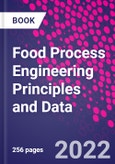Food Process Engineering Principles and Data provides an overview of topics surrounding safety and quality in processing foods. The book covers a range of physical properties of foods, providing background information on the physical, chemical and engineering properties of foods to ensure food safety and perform engineering calculations. Chapters are self-contained, with comprehensive charts of food properties, making this unique a great reference for scientists who need a single, handy source of information. Written by an authority on the physical properties of foods and food engineering, this book is ideal for food scientists, technologists, manufacturers and processors.
In addition, chemical engineers and biotechnologists will also benefit from the content of this comprehensive title.
Please Note: This is an On Demand product, delivery may take up to 11 working days after payment has been received.
Table of Contents
1. Introduction to food2. What is it; major food types, complexity, biological variability
3. Food processing processed foods
4. Food composition- food composition tables- benefits and limitations
5. Food nutritional value Atwater factors
6. Food pH pH values for different foods- acid and low-acid foods
7. Units and dimensions
8. Mass balances
9. Some Physical concepts, e.g. derived units, velocity, momentum, acceleration, force, energy and work
10. Food size, shape and other physical characteristics
11. Density and specific gravity
12. Viscosity simple rheology
13. More complex rheology
14. Surface properties
15. Thermal properties
16. Specific heat
17. Latent heat
18. Enthalpy and enthalpy data for food
19. Heat balance calculations
20. Heat transfer
21. Mechanisms, steady state and unsteady state
22. Conductions and thermal conductivity
23. Convection and heat film coefficients
24. Overall heat transfer coefficients and heat exchangers
25. The electromagnetic spectrum, food processing and food analysis
26. Reaction kinetics
27. D values and Z values, thermal process calculations strengths and weaknesses
28. Properties of steam and refrigerants
29. Properties of air-water systems
30. Some electrical properties, temperature measurement
31. Mass transfer diffusion
32. Packaging material properties!
33. Membrane processing
34. Combined heat and mass transfer e.g. drying
35. Unit Operations
36. Novel processing methods
37. Processing measurements; temperature, pressure and flow
38. Homogenisation, size reduction
39. Food colour
40. Food flavour
41. Food texture
42. Water useage/Energy conservation/waste and its disposal
43. Emerging topics, e.g. sustainability, 3-D printing








